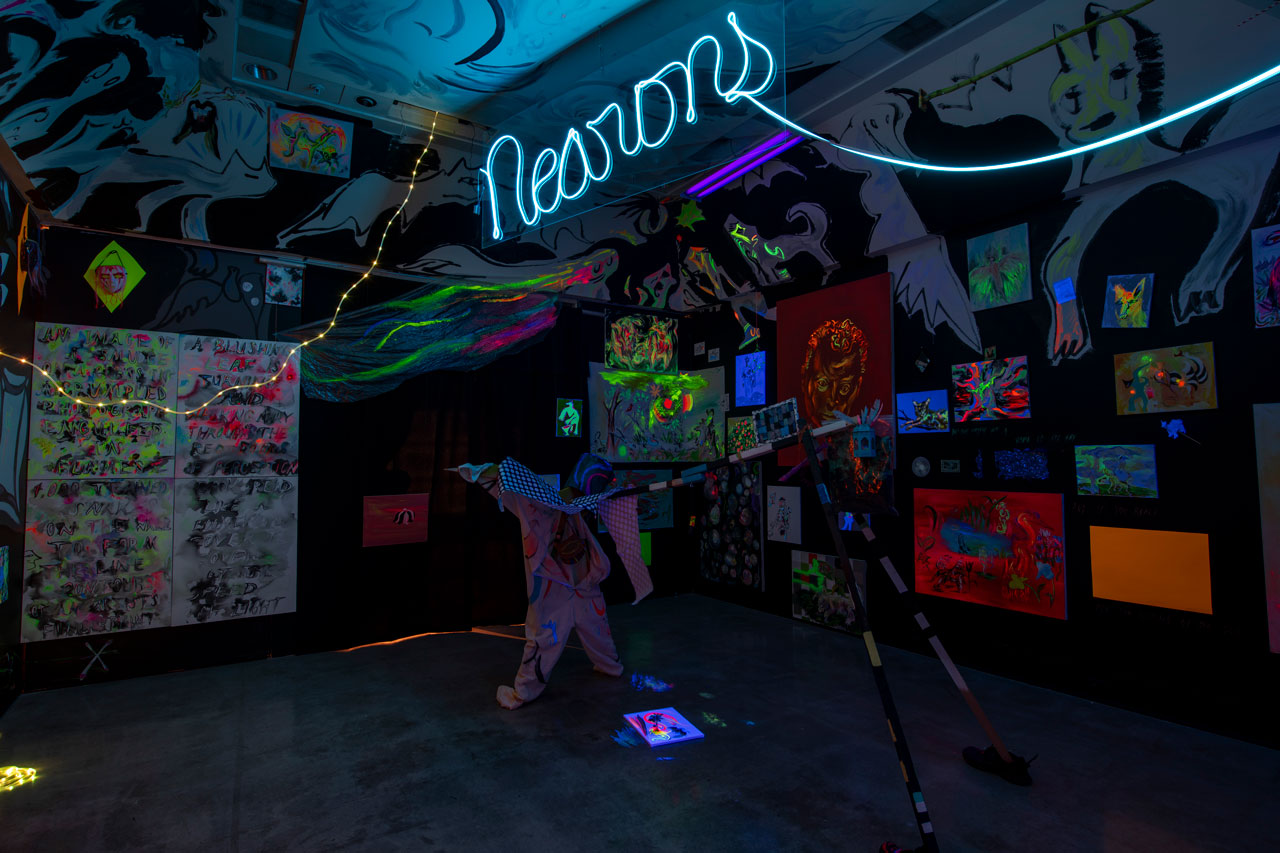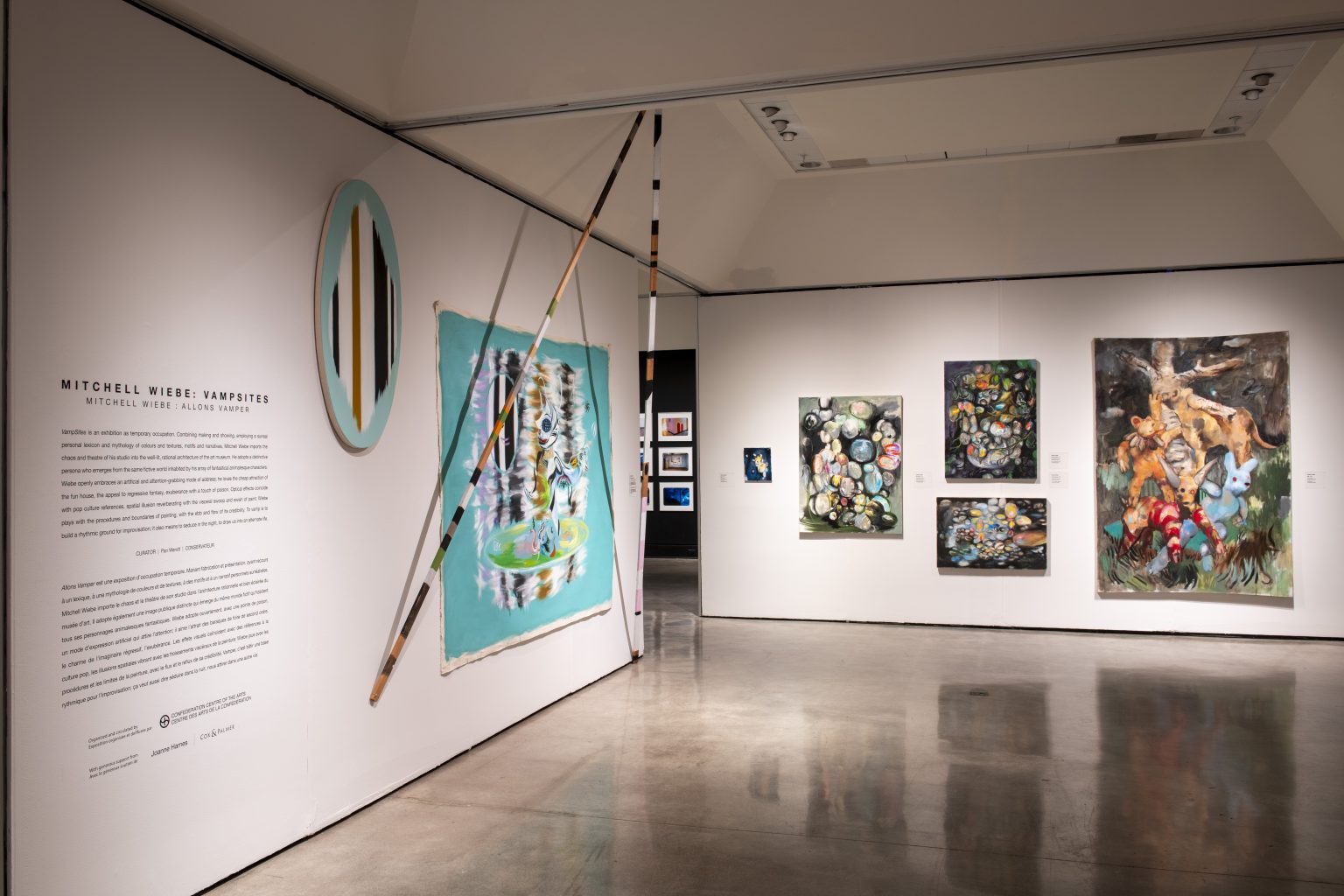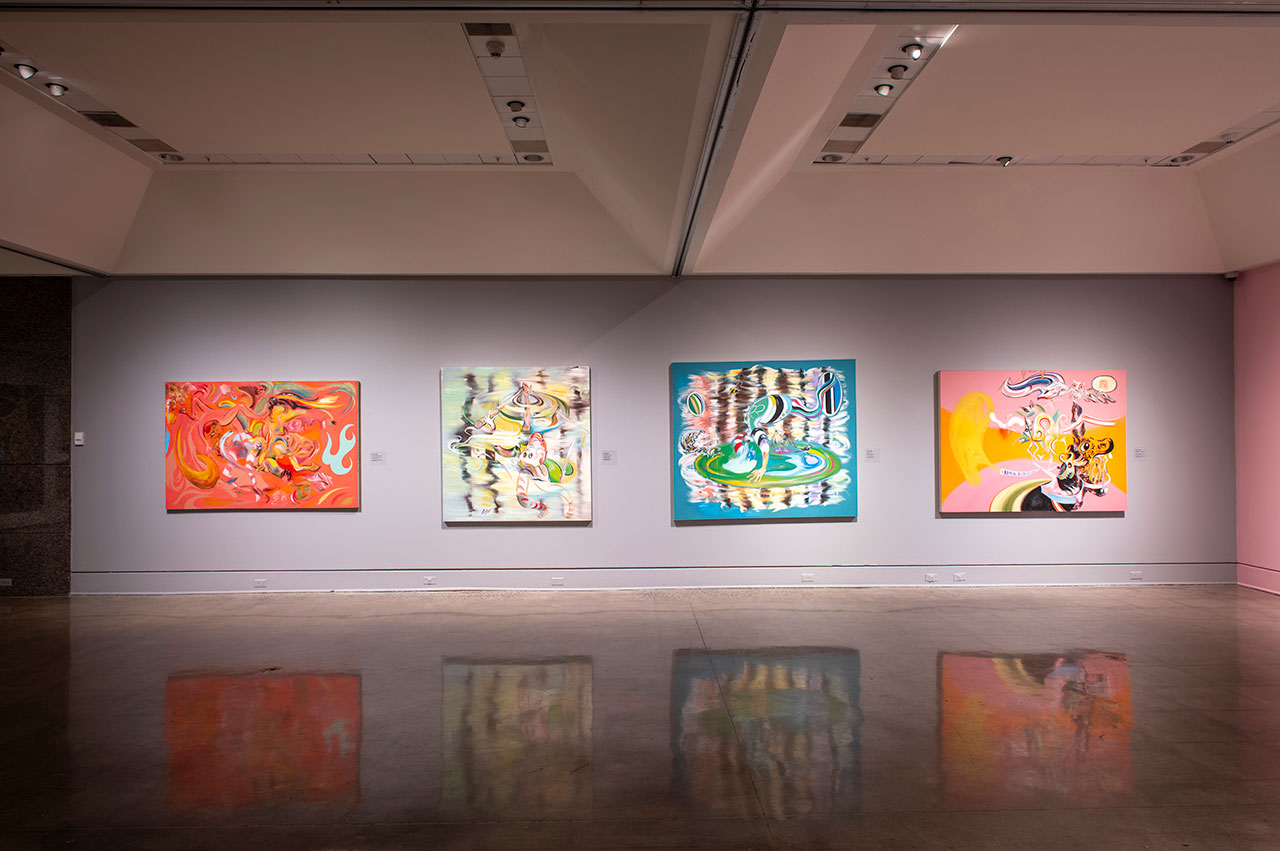NSCAD alumni Mitchell Wiebe talks about his work and holding concurrent exhibitions in Nova Scotia this summer

With two shows running concurrently in the city, 2024 is a summer of love for Halifax-based artist Mitchell Wiebe (MFA 1996).
The first show, VampSites, marks the reopening of the Art Gallery of Nova Scotia, running from June 8 to Sept. 30. Curated by Pan Wendt, the exhibit was organized and circulated by Confederation Centre for the Arts in Charlottetown, P.E.I.
The second show, Third Elbow, features Wiebe’s work alongside Kayza DeGraff-Ford, Craig Stuart Love, and Johanna Steffen. It is showing at the Saint Mary’s University Art Gallery from April 23 to July 14.
After completing his BFA from ECUAD in Vancouver, Mitchell Wiebe moved to Halifax to begin his MFA at NSCAD and has made a life as an artist in his adopted city where he practices painting, music, installation, and performance.
Wiebe grew up in Regina, Sask., and found an early appreciation of a local whimsical approach to art, particularly ceramics. Often populated by strange characters, Wiebe’s paintings echo social scenarios in a bombastic, pointed, and playful manner. Collaborations with artists such as Ray Fenwick, Graeme Patterson and Craig Leonard inevitably get distilled back at the studio, where large canvases carry blobs and impressions of the rich experiences. Wiebe’s paintings can be found in collections throughout Canada, the U.S.A., Germany and Italy.
Q: I wanted to talk about the fantastic, or the whimsical. There are other mediums like literature or film where it’s relegated to a kind of genre, but with painting in particular, the fantastic is considered legitimate. What is it about this medium where the fantastic has a welcome home?
Mitchell Wiebe: It’s funny because I just wrote a note in my studio recently about it and I was playing on that notion of suspended disbelief with writing. With constructing a painting, I was thinking it’s like suspending belief, maybe to get to the fantastic. It’s like constructing a song. You have to make it flow, get all these things that go into it, to create the situation so that the kind of lyrical quality can happen.
The term ‘whimsy’ has been coming up a lot with these shows with my work and I feel with art that that used to be almost a bad word. I have this idea, this notion, of reverse magic realism. You start with the fantastic and then get to something mundane.
Q: I was thinking about approachability and difficulty in your work. Through the humour, play, colour, your paintings are approachable on the surface, but they draws viewers in and take you somewhere else. Then the difficulty begins…
MW: That makes me think that I do set something up. A subtle nuance of social interactions, being played out. And so sometimes there’s kind of oblique social structures played out in these characters. It’s not direct.
Q: It’s not a heavy-handed critique. When I think of the black light room in VampSites, it’s like a conversation is underway. Is it an invitation, or do you point toward an alternate way of seeing or living? Do you think about those kinds of things?
MW: I think about it, but it’s kind of like constructing the monster of the demonstrative. When you’re doing stuff so it becomes a mathematical equation, I think it becomes less interesting. I like the casualness of a song that can have a muttering of something at first; it sounds like it’s just part of the melody, the tune, and then you listen and think – Oh, I’ve never really listened to it that way! Layers of meaning can come out, but without being heavy-handed. I don’t like a finger wagging at me for sure.

Q: I was thinking about the importance of the studio for you as a place of work and as a social space. Like the black light room, the studio is in the gallery. Would you be happiest if there was a merging of the two?
MW: It goes way back early to when you first got your own studio in art school. You make it your own space, you kind of build it up. And then yeah, that just continued and now there are these shows, it’s encouraged to bring that into the museum or the art gallery.
Q: Was that your idea? Or was it the curator?
MW: Both! Pan was in my studio and he looked around and he said, “Oh, you should do this right in the museum.” If you could bring this in, what you’re doing here, it will become more of an installation that is like a natural evolution. But it comes out of a natural kind of extension bringing that studio environment into the aesthetic, creating an environment where chance occurrences can happen.
Q: You spent a lot of time both at St Mary’s Art Gallery and the AGNS, working in the space like a studio. That’s not something I would think is normal in a show construction.
MW: It’s the generosity of the spirit of these institutions to allow that because not every situation is like that. But whenever I have a chance to work in a space, the more time the better, because then you can edit and move things around. You can try things out. See how they work. I also like all that to kind of occur in a painting. Like that black light gallery, the other day I walked in there and it felt good because it felt like I was walking into a painting, which was great. And a very weird painting to construct.
Q: What about the role of performance? You use alternative lighting, new walls, dramatic side rooms. The viewer has to interact or move into different positions. There’s performance related to that, or even in the work itself – there’s always a lot of movement in your paintings, people moving around. Not to mention all the bands or performance pieces you have participated in. How do you see these two practices, performance and painting, working together?
MW: Well, I always think the measure of a good song is if I’m humming the bass line, or it’s stuck in my head. Maybe it’s creating an atmosphere, like the wavy plastic screen in this show [at the Third Elbow show], seems like a layer of distortion. You still see the picture. But then you also get this feeling of it vibrating through the screen.
It’s funny though. I was talking to someone recently about songs and paintings being similar. I was saying, “You know, these blurry stripes here set up a rhythm.” And they said, ‘I don’t see those blurry stripes.’ I guess everyone sees things differently. The intention in the marks is a picture. I make a picture and then whether they see what I see – I don’t know.
You can’t say, “Oh, listen to this song, you’re gonna love it.” If someone does that to me, I usually don’t like it. But I might come to it on my own terms. I feel like painting is like that too. You come to it on your own terms.
It’s funny you mentioned pathetic art and Mike Kelly. I also think about Paul McCarthy and performance. It’s kind of pathetic, but going somewhere positive with it. It’s really abject humour. So, I think stuff like that kind of chimes with the way I’m thinking.

Q: One thing seeing these two shows impressed upon me was how much joy is in your work.
MW: You gotta turn it positive! I did get that sense too, when the shows all hung at AGNS especially. I felt like there’s this joy coming off the work. I’m like, “oh, great!” Because you forget exactly [how it happened], you’re too in it. You can’t see it clearly, not really, but then you take a break, come in and see it.
Q: How did that work, working with a curator, and assembling decades of work? It must be a mental and emotional process.
MW: It’s nice. I liked it, having an editor, having other people coming and working with me. Sometimes they can get to the essence. I can’t really. I’m involved in everything, but it’s like fractals, there’s a bit of everything in everything. On one level they’re all the same. And then on another level, they’re very different. In order to organize with a bunch of paintings, it’s nice to have some other eyes to look at it.
Q: How do you approach that? Do you assemble works thematically, or is the discussion more technical? How do you work through that?
MW: What’s really striking me with these shows is I’m realizing the eclectic nature of making a painting work is if it can bring in all these other elements at play. Then, sometimes, there are certain paintings that can happen in a group because there are common tones; like these ones are nighttime, weird forest paintings. Whereas if it’s an eclectic arrangement everywhere, then it just gets too busy or too loosey goosey.
Because I’m working on multiple series simultaneously, to organize it for people to see, it’s nice to cluster; but the organizing ideas around those clusters is different for each show. At Saint Mary’s, there are different artists included, so there are groupings, but at the AGNS working with Pan, we organized that middle room to clearly show: here’s a painting, and another painting, and another – finding a succession that seems to work. Yeah, we tried out quite a few arrangements. It takes a while to get it right.
I like the weird focus that’s happening in those paintings, particularly on that gray wall when you walk in. There was also the luxury of having a whole bunch of work to choose from, to find ones that sit well together.
Q: It was interesting to hear your analogy between music and painting. I know you listen to a lot of music when you’re working. How does one influence the other? Are they literally tied or is it just subconsciously working on you?
MW: I did have this one dream about color and music. In the dream I’m looking through my record collection, but I was looking for a colour. It was this kind of deep blue-green. That’s when I realized, “Oh, I think that’s synesthesia!” It kicks in but it’s related to sound and color. I can’t just pull it up as a tool. It just happens.
Q: The nice thing about a performance is the ephemerality or immediacy of it. That punk idea of just going out and doing it, how do you get that into painting?
MW: I think that the casualness and the subtlety that happens in a lot of punk music definitely crosses over into painting because I like that stuff. You talk about ephemerality, like the subtle things that happen in a painting would only happen in that painting. There are things that happen that are just so subtle and are hard to even map out, but you can have it occur.
Q: I feel like there is a certain in the moment-ness or immediacy at work in your paintings. Is that a fair assessment?
MW: I hope so because one of my first appreciations of art was being with a friend in a museum looking at a Cezanne painting and talking about how we could see the decisions that that were made in the paint. And so that’s a big thing for me, I want the decisions to be visible.
Q: How come?
MW: It allows you into the thinking process. It allows the viewer a way in.
Q: You’ve spent your career in Halifax as an artist. Being a practicing full-time artist in a region of Canada and not in the centre of Canada must require a certain amount of dedication and commitment. Could you talk about that a little bit?
MW: When I first moved here, I felt like it’s just too difficult to be an artist. I thought it’d be so tough. And in a way it is, at times, but there’s freedom. It’s something to do with an oblique intersection, there’s a certain freedom and an experimentation, not being under a tight schedule. But from another perspective, this is a pretty central area. This is the centre of the Maritimes. So, we’re kind of lucky in that way. I feel like it can be both. It can be peripheral, but also central.
We’re kind of amphibious: we’re existing in the ether and on land. It feels like that sometimes out here. I like that about living out here. I love that the air coming off the ocean is really fresh and sometimes it’s boggy, foggy, but then other times it whirls around and you get breeze and ice.
Q: Your work ethic must be pretty fierce.
MW: It’s just what I do. A lot of people have multiple jobs, most people do; but it’s not like just multiple jobs to pay rent. People have the time, which is valuable to be able to do. You can have an art practice. It takes 15 minutes to get across town here. In a lot of cities it takes two hours, whereas here you could spend those two hours in your studio. You can actually spend a lot of time in your studio if you want to.
Q: You did your BFA at Emily Carr, and then you came and did an MFA here. What did NSCAD do for your art practice?
MW: Well, it has an interdisciplinary quality. When I was a student, I had 24-hour access. Which was really good. Because sometimes you get struck in the middle of the night, and you want to work, so you can just be doing it all the time. I think that’s what you got to do is just allow yourself to be completely immersed. Also, the fact that all the areas of study are all together – designers, fine arts, it’s all mixed. That’s really important, because then you get a sense of all the mediums. The crossover can be pretty fluid.
Q: Following up on the freedom of being an artist in Halifax and feeling free from certain constraints. In your career as an artist, you’ve had representation and you’ve gone without it. What’s your attitude towards that relationship?
MW: I used to think that was the ideal, if I could just have one show a year, that would be great. But then, as time goes by, I’m not so sure. I think it’s more about a good fit with people, personalities getting along, a conversation happening. It’s good if you can relate.
